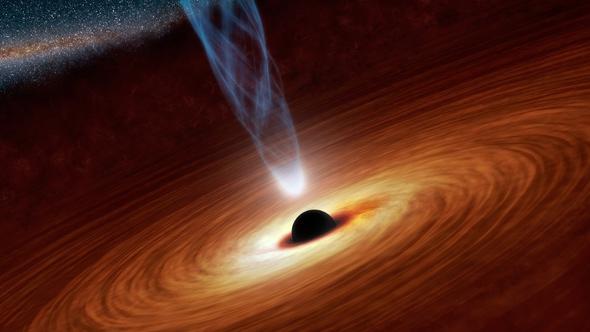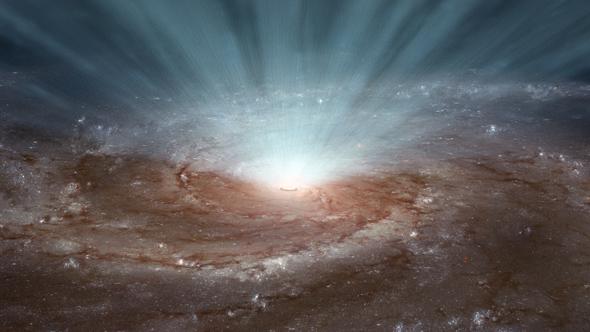When you think of black holes, you probably think they are chaotic destroyers of all; wandering through space devouring everything in their path, and once something gets too close, it’s gone forever.
That’s a little unfair. Actually, a lot unfair. They only eat stuff that’s nearby, for one thing. And for another, they’re sloppy eaters. Not everything falls straight down their gullet; a lot of it can swirl around the black hole in what’s called an accretion disk. Material in that disk can be heated to terrifyingly high temperatures, millions of degrees, causing it to glow fiercely bright. It can blast out X-rays, and even create an intensely strong wind of material that flows away from the black hole.
We also know that every big galaxy we look at has a supermassive black hole in its very center. If that black hole has gas and matter falling into it, the accretion disk can be huge and ridiculously, soul-crushingly bright. The luminosity of such an object can easily outshine the hundreds of billions of stars in the host galaxy, and make the black hole visible clear across the Universe.
This sets up an interesting problem. When you have a monster in the middle like that, how does it affect the rest of the galaxy? A curious fact was discovered many years ago; the mass of the black hole in a galaxy seems to correlate with how the stars in the galaxy orbit. You might think “duh” to that, but hang on. Even though a black hole can have a mass of a billion times the Sun, that’s a teeny tiny fraction of the mass of a galaxy with a few hundred billion stars in it.
Somehow, the black hole is affecting the galaxy around it on a huge scale. How?

Photo by NASA/JPL-Caltech
The obvious way is through this wind, this cosmic hurricane of particles blasting outward from it at high fractions of the speed of light. Studying that wind is maddeningly difficult, though. For example, when we look right at the center of the galaxy, all we can see is the extremely narrow slice of gas between us and the black hole. That gas absorbs the light coming from the accretion disk, blocking it. As it happens, different kinds of atoms block different colors of light. One type of iron, for example, that has a lot of its electrons ripped away from the intense energy blasting away nearby, is really good at absorbing a very specific wavelength of X-rays.
That can tell you something about the gas, like how hot it is, and how fast the gas is moving away from the black hole. But what it doesn’t tell you is the overall shape of the wind. Is it blowing out spherically, like an expanding balloon, or is it focused into narrow beams?
Lots of black holes have those beams screaming away from them. We know this because we can see them. But not every black hole has them. So how can you figure out the shape of the wind?
Some astronomers have just announced they found a way. The black hole they observed is a billion-solar-mass beast in the center of the galaxy PDS 456, which is about 2 billion light-years away. It’s fairly well studied, and is a good example of a typical “active galaxy,” one with an actively feeding black hole in its core.
They observed it using two different observatories: XMM-Newton and NuSTAR. Both can sort incoming X-rays into their individual energies (think of that like color in light we see). XMM-Newton could see the gas blocking the black hole directly, but can’t detect any gas anywhere else. NuSTAR, however, is able to see the kind of X-rays that would be coming from gas surrounding the black hole … and it did. Looking at the spectrum of the X-rays, it found the unmistakable signature of gas expanding outward in a sphere (if you want technical stuff, it saw a classic P-Cygni profile).
This is a big deal. The geometry of the expanding wind can tell us its total energy. Think of it this way: Imagine you have a 1-watt light bulb. It looks pretty dim, because it’s sending light out in all directions. Only a little bit of the light is heading into your eye. But if I have a flashlight, it focuses the energy emitted, so it can gather up all the light being wasted in other directions and beam it toward you. The bulb in a flashlight can be a lot dimmer, but still look brighter to you because of that.

Photo by X-ray: NASA/CXC/U.Birmingham/M.Burke et al.
And that’s the basis of these new observations. They saw that the wind from the black hole is expanding in all directions, which means the astronomers could determine the overall physical nature of the wind. It turns out the black hole is blasting a wind that totals 10 times the Sun’s mass every year—and mind you, that vast amount of stuff is screaming out at tens of thousands of kilometers per second. If I’ve done my math right (and I have; I checked), that means the mechanical energy in that wind is a staggering 10 trillion times the total energy the Sun emits every second.
Ten trillion.
And that wind is blowing outward in all directions, so it can easily affect the gas around it, even thousands of light-years away. This in turn would affect how stars form in a galaxy, and explain the relationship we see between the black hole and the stars in the galaxy around it.
And here’s the really cool thing: We think those big black holes form at the same time as the galaxy itself. As the zillions of tons of gas swirl around in the proto-galaxy, assembling itself into stars, some of it is falling into the nascent black hole in the center of that maelstrom. It forms a disk around the black hole, heats up, and starts to blast out a wind. This wind slams into the gas around it, all around it, blowing it hither and yon.
When the galaxy finally coalesces as a massive island universe of billions of stars, the motions of the stars themselves still have the fingerprint of the black hole’s wind imprinted on them, even billions of years later. And that wind may have helped trigger more stars being born as it rams into and compresses the gas around it, just as it can also shut down star formation by blowing that gas away.
Our galaxy, the Milky Way, has such a black hole in the middle. It’s not a big one as they go, a mere 4 million times the mass of the Sun. But 10 billion years ago, when our galaxy was forming, it may have been active, and may have affected the young galaxy around it as well.
When you go outside at night and look at the stars, think on that. If you can see Sagittarius, you’re looking toward the center of our galaxy, where that monster dwells. It’s surrounded by billions of stars, so distant from us their light merges into a soft glow. But they’re there, those myriad stars, and their motions, their formation, even their existence itself may have been profoundly influenced by a black hole that we didn’t even know existed until a few decades ago.
Ah, science. It allows us to wonder about the inner workings of the Universe we live in, and then shows us how the pieces fit together. If there is a grander, more exhilarating adventure than that, I don’t know what it is.
